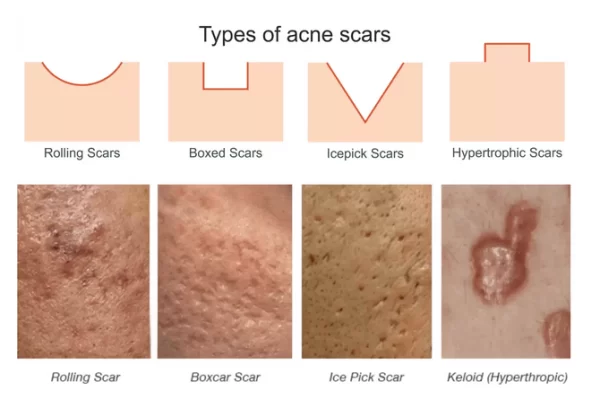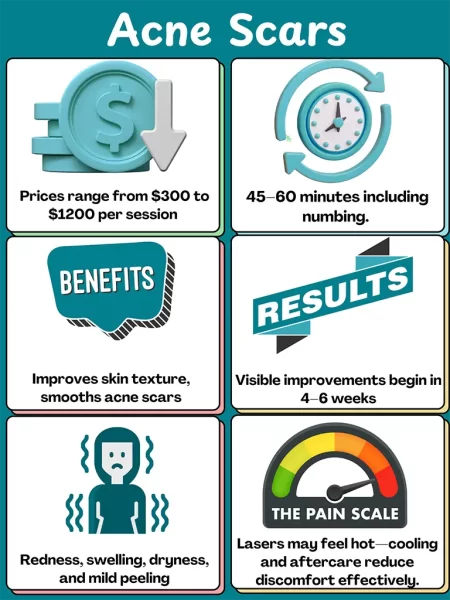Classification of Acne Scars in Edmonton – Know Your Scar Type
Not all acne scars are created equal. Understanding the type and severity of your acne scars is the first step toward choosing the most effective treatment for acne scars. This guide, created to complement our main acne scarring service page, explains the categories and characteristics of acne scars seen in our Edmonton clinic. By identifying your scar type, you and your provider can develop a targeted plan to improve skin texture and appearance.


Quick summary
Cost & Pricing
What To Expect
Mechanism of Action
Benefits & Results
Discomfort & Pain Level
Side Effects & Downtime

Why Classification Matters
Each scar type responds differently to treatment. Depressed scars may benefit from procedures that stimulate collagen or release tethered tissue, whereas raised scars often require therapies that reduce excess collagen. Our team at Albany Cosmetic & Laser Centre assesses your scar pattern and skin type to recommend the most appropriate combination of laser therapy, microneedling, fillers or subcision. A personalised approach leads to smoother results and fewer treatment sessions.
Types of Acne Scars
Atrophic Scars (Indented)
Atrophic scars result from a net loss of collagen and appear as depressions or pits in the skin. They are the most common form of acne scarring, affecting the majority of patients. Atrophic scars are further divided into three subtypes.
Ice Pick Scars
These narrow, deep scars look like tiny punctures. They extend vertically into the dermis, creating a V‑shaped tract. Ice pick scars tend to be less than 2 mm in diameter and may be resistant to superficial treatments. Procedures such as microneedling, chemical peels and TCA CROSS can help break down scar tissue and promote collagen formation.
Boxcar Scars
Boxcar scars are round or oval depressions with sharply defined vertical edges. They are wider than ice pick scars but shallower, resembling varicella (chickenpox) scars. Boxcar scars may be shallow or deep and are often located on the cheeks or temples. Fractional lasers, dermal fillers and subcision can improve their appearance by filling the depression and stimulating collagen.
Rolling Scars
Rolling scars create a wavy, undulating appearance to the skin. These broader scars result from fibrous bands tethering the dermis to the underlying tissue. Subcision is a common treatment that releases these bands. Combination therapies with microneedling, radiofrequency or fillers can further smooth the skin surface.
Raised Scars
While most acne scars are indented, some develop due to excess collagen production during healing. Raised scars are more common on the chest, back and shoulders and may be itchy or firm. They include hypertrophic scars, keloids and papular scars.
Hypertrophic Scars
Hypertrophic scars are raised but remain confined to the boundary of the original lesion. They often appear within a few months of an acne breakout and feel firm. Treatment typically involves corticosteroid injections, silicone gel sheets or laser therapy to flatten the scar and reduce redness.
Keloids
Keloid scars extend beyond the original wound edges. They form thick, irregular lumps that may continue to grow over time. Keloids are more common in people with darker skin tones and often require combination therapy, such as steroid injections, cryotherapy or laser treatment, to reduce size and prevent recurrence.
Papular Scars
Papular acne scars present as small, skin‑coloured or lighter‑coloured bumps on the nose, chin or jawline. They may resemble acne but are a type of raised scar. Treatment options include intralesional corticosteroids, microneedling or radiofrequency to flatten the bumps and improve texture.
Flat Pigmentation (Post‑Inflammatory Hyperpigmentation)
After acne clears, you may notice flat, pigmented spots called post‑inflammatory hyperpigmentation (PIH). These marks are not true scars because they do not alter the skin’s texture and usually fade over time. Sun protection, topical lightening agents and gentle chemical peels can help accelerate fading. It is important to differentiate PIH from atrophic or raised scars when planning treatment.
Severity Grades of Acne Scars
Dermatologists use grading systems to assess the severity and visibility of acne scars. The widely used Goodman and Baron qualitative scale divides scars into four grades based on texture and visibility:
- Grade 1 (Macular): Flat marks that may be red, brown or lighter than the surrounding skin. Colour is the primary concern rather than contour.
- Grade 2 (Mild): Superficial atrophic or hypertrophic scars that are not obvious at a distance of 50 cm and can be covered easily with makeup or natural shadow.
- Grade 3 (Moderate): Atrophic or hypertrophic scars that are visible at 50 cm and cannot be covered easily by makeup, but they flatten when the skin is stretched.
- Grade 4 (Severe): Deep atrophic or hypertrophic scars that are evident at social distances and do not flatten with manual stretching.
Factors Influencing Scar Formation
Several factors determine whether acne will leave a lasting scar. Genetics plays a role—some individuals are more prone to keloids or severe scarring. Skin tone influences the type of scar; darker skin tones have a higher risk of keloids and hyperpigmentation. The location of the acne lesion matters: areas under tension, such as the chest or shoulders, are more likely to develop raised scars. Proper wound care during acne breakouts, including avoiding picking or squeezing lesions and using appropriate acne treatments, can reduce the risk of scarring.
Choosing the Right Treatment
Once we determine your scar type and severity, we can recommend targeted treatments. Atrophic scars may respond well to microneedling, laser resurfacing, chemical peels or dermal fillers. Rolling scars often require subcision to break fibrous bands, followed by collagen‑stimulatory treatments. Raised scars such as hypertrophic and keloids may need steroid injections, silicone therapy or laser therapy to flatten them. Post‑inflammatory hyperpigmentation can be addressed with topical lightening agents, peels and sun protection. A personalised treatment plan ensures optimal results and complements the information provided on our main acne scarring page.
How To Identify Your Acne Scar Type
Determining your scar type requires close examination. Icepick scars look like small pinholes, while boxcar scars appear broader with defined edges. Rolling scars have a wave-like appearance, making the skin look uneven. In contrast, hypertrophic and keloid scars are raised and can sometimes feel firm. Identifying the type will help your skincare provider suggest the most effective treatment method.
Request Your Appointment Today
Request your consultation today and discover how our treatment can refresh your appearance.
Call us at (587) 520‑2835 or use our online booking form to schedule an appointment.
Read our privacy policy here